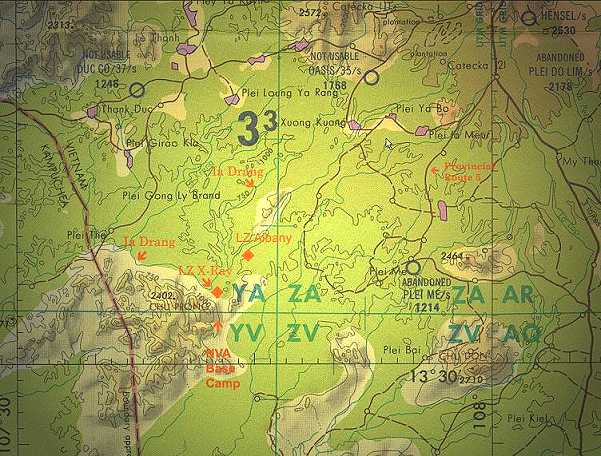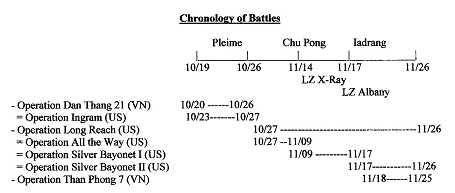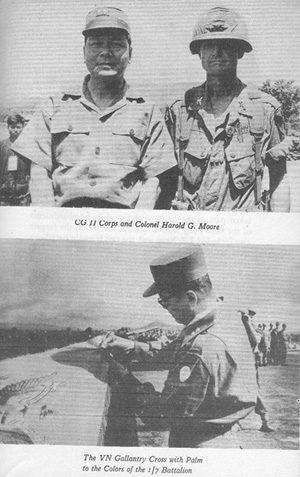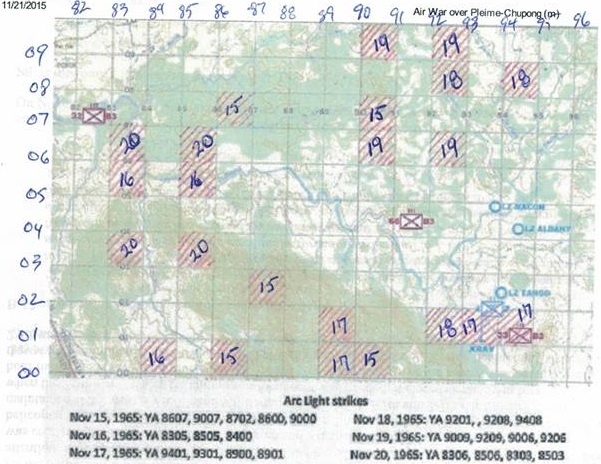
The battle at LZ X-Ray occurred in November 1965 - 45 years ago - and yet military historians, authors and even military authorities involved in the battle, have not depicted it accurately for failing to mention the following significant facts about the battle:
Right name for the Battle
It is not appropriate to call the battle at LZ X-Ray The Ia Drang Valley battle. ARVN II Corps called this battle the Chu Pong battle which occurred at the foothill of Chu Pong massif and reserved the name of The Ia Drang Valley battle to the one conducted by the ARVN Airborne Brigade which occurred further up North by the Ia Drang river. (see Ia Drang Battle? Which One?)

In fact, the battle at LZ X-Ray was part of a trilogy of battles - Pleime-ChuPong-Iadrang - in the Pleime Campaign.

First Strike in Chu Pong Massif
When 1/7th Air Cavalry Battalion, 3rd Air Cavalry Brigade, jumped in LZ X-Ray and engaged the enemy on November 14, 1965, it was not the first time that the troops of US 1st Air Cavalry Division encountered the VC in the remote area of Chu Pong massif. The first encounter with the VC in that area was conducted by 9th Air Cavalry Squadron which engaged a unit of NVA 66th Regiment on November 3, 1965. This unit was the advanced column of the 66th Regiment recently setting foot in the Highlands.
General Kinnard noted in his Pleiku Campaign report:
The confidence of the newly-infiltrated 66th Regiment was badly shaken by the audacious ambush sprung by the Cavalry Squadron, in the very heart of the Chu Pong-Ia Drang complex. The 8th battalion had gotten itself bloodied before it had been in country for two days and, by losing a prisoner, tipped off its presence in South Vietnam.
Precise Knowledge of VC Unit Positions
The public still strongly believe the myth that stipulates the ignorance of the whereabouts of VC units when Colonel Hal Moore led his troops into Chu Pong massif:
- US had little intelligence and did not know how many enemy. (Comment from a person after watching a video on the Ia Drang battle). - The sketchy American intelligence Moore was provided said the area was home base for possibly a regiment of the enemy. (Joseph Galloway, October 18, 2010) - After arriving in Vietnam, he learns that an American base has been attacked, and is ordered to take his 400 men after the enemy and eliminate them, despite the fact that intelligence has no idea of the number of enemy troops. (wikipedia on the movie We Were Soldiers...)
However the fact is that when US 1st Air Cavalry Division Commander sent 1/7th Air Cavalry Battalion in Chu Pong massif, he knew precisely the coordinates of the positions of the three NVA regiments. He noted that his intelligence indicated the positions as followed on November 11, 1965:
The disposition of the 66th on 11th November had its three battalions, the 7th, 8th and 9th, strung along the north bank of the Ia Drang (center of mass Vic 9104).
The 33d Regiment still maintained its positions vicinity ANTA Village (YA940010).
The 32d Regiment was still north of the Ia Drang (YA820070)
Preemptive Attack
Interrogations of captive NVA prisoners and ralliers revealed that NVA B3 Front Command intended to attack Pleime camp a second time and to overrun immediately with all three regiments supported by an anti-aircraft battalion and a heavy mortar battalion. The attack date was set for November 16, 1965.
As a counter-measure, a preemptive strike was set for November 14, 1965 when the enemy units were at their weakest posture, because the anti-aircraft and the heavy mortar battalions were still two day away on the Ho Chi Minh trail.
Ground Preparatory Phase
The knowledge of the date of the second attack on Pleime camp was acquired quite early which allowed the US 1st Air Cavalry Division Commander to make preparation for the preemptive strike way ahead of time, precisely on November 09, with a diversionary tactic which consisted of switching the operational direction eastward, inducing the enemy in thinking the Americans had lost their trace. General Kinnard wrote in his Pleiku Campaign report:
The movement and shift in emphasis from west to east was to further stimulate a forthcoming decision from NVA division headquarters.
Colonel Hieu, II Corps Chief of Staff, was more specific in this regard by stating in Why Pleime:
On 9 November, the movement and shift in emphasis from west to east commenced (...)
Convinced that friendly forces had lost tracks of its units, VC Field Front quickly made a decision to regain its advantage with an attack. The target again was Pleime and the date of attack set at 16 November.
Operational Concept
Most historians are still preoccupied with debating which side was surprised by the other or was ambushed by the other and seem not to be aware of the operational concept of the attack at LZ X-Ray which consisted of using the 1/7th Air Cavalry Battalion in a blocking position preventing the enemy troops to flee down south from November 14 to 16, while using B52 bombers to crush them up north from November 15 to 16, and subsequently right at LZ X-Ray on November 17 after pulling out the two American battalions, one toward LZ Columbus and the other toward LZ Albany. The battles engaged on the ground at LZ X-Ray and LZ Albany accounted for about 2,500 enemy KIA, while the B52 air strikes from November 15 to 17 accounted for approximately 2,000 enemy KIA.
If the intention were to attack and annihilate the enemy with ground forces, then the US 1st Air Cavalry Division Command would have thrown in its troops in the center of the enemy formation instead of at its southern fringe in the blocking position and would have committed its entire forces of three brigades in order to be able to overpower the three enemy regiments instead of committing only two battalions.
Control of the Battle
General Kinnard, US 1st Air Cavalry Division Commander, contributed in creating the illusion that the Pleiku Campaign which comprised the battle at LZ X-Ray was conducted totally independent of ARVN II Corps Command, while in fact it remained under ARVN II Corps Command.
A proof can be found in the following two photo ops which show General Vinh Loc standing next to Colonel Hal Moore and pinning the VN Gallantry Cross with Palm on the Colors of US 1/7th Air Cavalry Battalion.

A second proof was the fact ARVN II Corps Command received from US 1st Air Cavalry Command , among others, the After Action Report of 1/7 Air Cavalry Battalion submitted by Colonel Hal Moore and dated December 1965, and the After Action Report Pleiku Campaign of US 1st Air Cavalry Division submitted by General Harold Kinnard and dated March, 1966. Colonel Hieu, II Corps Chief of Staff, used copiously these two classified documents (reference #30 and #32 respectively) and in particular, literally plagiarized Colonel Hal Moore's report in the drafting of his After Action Report Why Pleime.
Three things show that II Corps was in control of the Pleiku Campaign conducted by US 1 Air Cavalry Division.
First, it was II Corps that decided to have the US 1st Air Cavalry Division pursue the withdrawing enemy in the meeting at II Corps headquarters on October 26, 1965:
The decision made by II Corps Command to exploit the results of the first phase and to pursue the enemy was fully concurred by the US military authorities and agreement was reached to establish a close cooperation in operational activities. The 1st US Air Cavalry Division made the main effort with the Long Reach Operations and the ARVN Airborne Brigade acted as reserve, ready to participate on Corps order.
Second, II Corps Command formulated the combined operational concept between II Corps Command and US 1st Air Cavalry Command as followed:
Third, throughout the unfolding of Pleime Campaign, II Corps Command based on precise and solid intelligence obtained mainly through radio intercepts of Chinese Advisors' communications, dictated the timing of various troop maneuverings:
(To learn more, see Command and Control Skills in Pleime Campaign)
General Knowles reveals that the purpose for the insertion of the Air Cavalry troops at LZ X-Ray on November 14 was to “grab the tiger by its tail” and to hit its head with B-52 airstrikes from November 15 to 16. He also explains the reason for pulling out of LZ X-Ray on November 17 and moving to LZ Albany was “to grab the tiger by its tail from another direction” and continued to hit its head with B-52 bombs from November 17 to 20.

Conclusion
In summary, for failing to mention (1) the right name: not Ia Drang, rather Chu Pong, (2) the first strike in Chu Pong massif by 9th Air Cavalry Squadron, (3) the precise knowledge of VC unit positions, (4) the preemptive attack nature of the strike, (5) the ground preparatory phase, (6) the correct operational concept, and (7) the control of the battle in their accounts of the battle at LZ X-Ray, military historians - American and VC alike - presented those accounts through distorted lens, and the end result is a bias picture, to the detriment of ARVN command and combatants who participated in the Pleime Campaign: they are considered as incompetent military leaders and inefficient combatants.
Nguyen Van Tin
18 November 2010
- Hành Quân Pleime-Chuprong Oanh Tập B-52
- Vię̣c Xử Dụng Oanh Kích B-52 Trong Chię́n Dịch Ia Drang, Bí Mật Quân Sự Giữ Kín Nhất của Tướng Westmoreland
- Air War Over Pleime-Chupong
- Arc Light over Chu Pong Operation
- Catching a Thief Tactic in Pleime Campaign
- Pleime/Chupong Campaign Destroying B3 Field Front Base
- The Uniqueness in Pleime Counteroffensive Operational Concept
- Pleime Counteroffensive into Chupong Iadrang Complex
- The Unfolding of Strategic and Tactical Moves of Pleime Campaign
- Battle of Pleime
- The Truth about the Pleime Battle
- Intelligence Gathering at Ia Drang
- Intelligence, the Key Factor in the Pleime Campaign's Victory
- Roll Call of Combatants at Pleime-Chupong-Iadrang Battlefront
- "Victory at Pleime" ?
- Tactical Moves in Pleime Battle
- Kung Fu Tactics at Pleime Campaign
- Various Diversionary Moves in Support of Arc Lite Strike in Pleime Counteroffensive
- What if there was no master plan for Pleime Counteroffensive?
- Pleime/Chupong Campaign Destroying B3 Field Front Base
- A Few Things You Should Know about Pleime-Iadrang Campaign
- Things the VC Don't Want People To Know at Pleime Battle
- Reviewing "Why Pleime"
- Review of "Intelligence Aspects at Pleime_Chupong Campaign"
- Perplexing Maneuvers at Pleime-Chupong-Iadrang You Might Be Attempted to Question
- A Bird’s-Eye-View of Pleime Campaign
- Operation Dan Thang 21
- US Air Force’s Roles in Pleime Campaign
- Arc Lite Operation Planning and Execution in Pleime Offensive
- A Doctrinal Lesson on the Use of Arc Lite in Pleime Counteroffensive
- Command and Control of Arc Light Strike at Chupong-Iadrang
- A Military Genius in Action at Pleime-Chupong-Iadrang Battlefront
- Command and Control Skills in Pleime Campaign
- Behind-the-scenes Activities at Various Allied Headquarters During Pleime Campaign
- The Two Principals Players Of Pleime Chess Game
- Pleime Battle's Diary
- Pleime Campaign and Pleiku Campaign
- A New Look at Ia Drang
- Hành Quân Long Reach
- LZ X-Ray Battle (General Knowles)
- My Contributions to the Battle of Ia Drang in Wikipedia
- Operation LZ X-Ray
- Colonel Hal Moore’s Self-Aggrandizement in “We Were Soldiers Once ... and Young”
- Colonel Hal Moore Misunderstood his Mission at the Ia Drang Battle
- What Historians Failed to Tell About the Battle at LZ X-Ray
- Hal Moore and 1/7th Air Cavalry Battalion's Real Mission at LZ X-Ray
- Two Different Narrations of LZ X-Ray Battle by II Corps
- Ia Drang Valley Battle? Which One?
- LTC Hal Moore Summoned to a Woodshed Session?
- Colonel Hieu's Operational Concept for LZ X-Ray
- LZ Albany Battle - Chinese Advisors' Perspective
- A Puzzling Air Assault Performed by 1/7 Air Cavalry at LZ X-Ray
- Two Different Narrations of Than Phong 7 Operation by II Corps
- General Schwarzkopf's Naďveté In Ia Drang Battle
- Venturing into Lion's Den in Ia Drang Valley
- American Perspective of Pleime Battle
- General Kinnard's Naďveté in Pleime Campaign
- "No Time for Reflection at Ia Drang" ?
- Pleime Campaign or Pleime-Ia Drang Campaign?
- A Critique of General Bui Nam Ha's Opinions about Plâyme Campaign
- Commenting on General Nguyen Huu An's Account of Plâyme Campaign
- Crushing the American Troops in Western Highlands or in Danang?
- What Really Happened at Ia Drang Battle
- Case Study of a Typical Misinterpretation of Ia Drang Battle
- Ia Drang Battle Revisited
Documents
- Why Pleime
- Pleime, Trận Chię́n Lịch Sử
- Pleime Battle Viewed From G3/I Field Force Vietnam
- Long Reach Operation Viewed From G3/I Field Force Vietnam
- LZ X-Ray Battle and LZ Albany Battle Viewed From G3/I Field Force Vietnam
- Than Phong 7 Operation Viewed From G3/I Field Force Vietnam
- Arc Light Strike at Chupong-Iadrang Viewed From G3/IFFV
- Pleiku Campaign
- Intelligence Aspects at Pleime_Chupong Campaign
- Excerpts of General Westmorland’s History Notes re: Pleime-Chupong-Iadrang Campaign
- LZ X-Ray Battle (General Knowles)
- LZ X-Ray After Action Report - LTC Hal Moore and Colonel Hieu
- Than Phong 7
- 52nd Combat Aviation Battalion in Support of Pleime Campaign
- CIDG in Camp Defense (Plei Me)
- Viet Cong Requested Red China's Aid
- Battle of Duc Co
- NVA Colonel Ha Vi Tung at Pleime-LZ Xray-LZ Albany
- The Fog of War: The Vietnamese View of the Ia Drang Battle
- No Time for Reflection: Moore at Ia Drang
- 1st US Cavalry Division Gives Support in the Battle at Plei Me
- Plei Me Fight Stands As War Turning Point
- Plei Me Battle
- Seven Days of Zap
- Pleime Through New York Times' View
- First Engagement With American Troops at Pleime-Iadrang
- Pleime Campaign
- Crushing the American Troops in Central Highlands
- NVA 66th Regiment in Pleime-Ia Drang Campaign
- The Political Commissar at the First Battle Against the Americans in Central Highlands